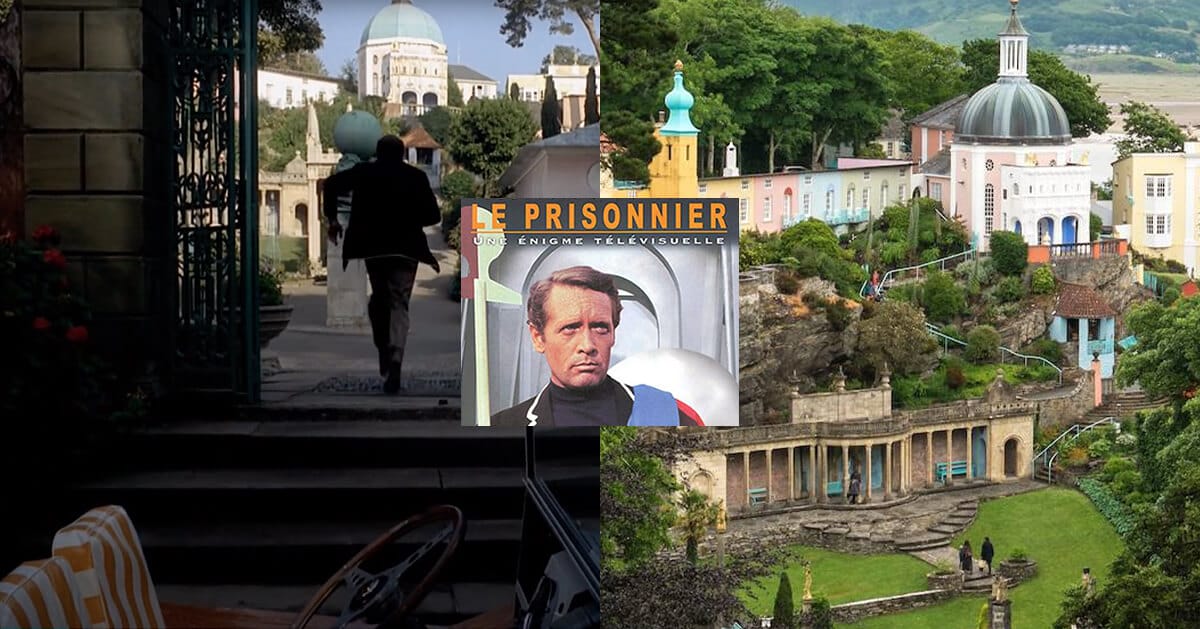Article
The prisoner: a series of lockdowns?

Created by George Markstein, former British secret service agent and writer and Patrick McGoohan, actor, the series was broadcast in 1967 on ITV in Great Britain and the following year in France on the second channel.
As shown in the credits of the Prisoner, the beginning of the series takes place in London. Viewers discover a man in a Lotus Seven on his way to MI6. He’s pissed and throws a letter on his superior’s desk. Inside, his resignation from counterintelligence. The car park that Patrick McGoohan enters is Q-Park Westminister, as we mentioned in our Fantrippers London Guide.
He then went home to 1 Buckingham Palace to pack his suitcase and go on holiday. He doesn’t have time to pack his bags, he is drugged with an anaesthetic gas and then wakes up in a mysterious hotel room. He then tries to understand what he is doing there and goes to inspect the premises. From the top of the church tower, he discovers that he is in a village.
He then tries to call the police but the area code does not exist. He then asks for a taxi to get out of town but he can’t. He’s locked up in the Village. Afterwards, he goes to a shop to buy a map of the city. Surprisingly, it indicates nothing but “the sea” and “the mountains” surrounding the city.
Afterwards, he is invited to No. 2’s house. He is greeted by a mysterious man who offers him food. He has a file of photographs of the former spy. In fact, some high-ranking men would like to know why he resigned from MI6.
Later, with N°2, they fly over the Village in a helicopter. The prisoner then discovered the building of the Supreme Council, whose members would be democratically elected. It is then renamed in N°6 by N°2. He’s furious and explains that he’s not just a number but a free man.
The series is therefore based on the prisoner’s attempts to flee the Village and to find allies for that purpose.
Portmeirion, the Confined Village
To shoot the series, George Markstein and Patrick McGoohan chose the city of Portmeirion in Wales. Located not far from Snowdonia National Park and the Portmadog Estuary, the town sprang from the head of Clough Williams-Ellis. This architect devoted 50 years of his life, between 1925 and 1978, to create the “ideal village”. For this, the eccentric billionaire wanted to recreate Portofino, an Italian city near Genoa.
The Baroque style of construction contrasts with that of the period. Everything is rococo, influenced even by Mediterranean habitats. The buildings have pastel colours, close to those of ice cream. The colonnades mingle with the domes and balconies, each one more whimsical than the next. The only hotel is in Victorian style while the Bridge House has Doric columns. As for the Cliff House, it has a trompe l’oeil on its façade. A small dog cemetery even rivals a stone boat on the beach or subtropical gardens. Everything’s crazy in Portmeirion.
Yet everything is still perfectly recognizable. Fans of the series can easily visit the Supreme Council building, the Dome, No. 2’s house, Prior’s Lodging, No. 8’s house, the central lawn that hosted the famous human-sized chess game, and No. 6’s house, now a souvenir shop. Patrick McGoohan’s all over it, on T-shirts and card games.
The “Village” covers an area of 30 hectares but has no real inhabitants, just employees who can welcome tourists.
The Prisoner, a series of hymns to freedom
At the time, The Prisoner was a major breakthrough in series production. Her surrealist staging and “cold war” atmosphere make her a very addictive suspense dystopia.
Rover -the white ball stifling any desire to escape-, statues equipped with cameras or incessant radio announcements, all its oppressions are to be compared to 1984, the novel by George Orwell but also to Fahrenheit 451, the book by Ray Bradbury. As for No. 6’s condition, it may also remind us of the myth of Sisyphus or the eternal beginning again. Closer to home, The Truman Show, the film directed by Peter Weir in 1998 may also make you think about it. Jim Carrey finds himself from birth in a setting and a history pre-determined for scientific purposes.
Why, today, are the confined ones rushing to watch this show? The prisoner is a hymn to freedom, the freedom we can no longer really exercise. An allegorical series par excellence, it is based on several philosophical concepts. In the first place, it tries to have the individual recognized as such and not as a replaceable element in a community. N°6 would be the same, while the Village would represent the Company.
In The Prisoner, the individual is manipulated, monitored and oppressed. It’s full of sub-culture and uninteresting popular entertainment. He’s also drunk on radio sounds that he can’t turn off. He also has to laugh and clap on demand. Democracy and freedom are therefore a mantra in the Village. The enemy would not be No. 1 but rather society, administration and technocracy.
As for N°6, he dreams of escaping it but he doesn’t succeed. Nevertheless, from time to time he wants to be able to isolate himself and express himself as an individual and not as a whole.
In the Village, there are submissive and resigned Germans, Russians, French and English. They are also to be put in opposition to No. 6’s desire for freedom.
The Prisoner, a very pop series
In just 17 episodes of 52 minutes, The Prisoner has become a cult series. She exerted a very strong influence on television programmes in the following years, but also in science fiction literature and popular culture in general. Thus, the series Lost and Twin Peaks were marked by The Prisoner.
Every year, the Six of One Society brings together fans of the series for a convention in Portmeirion, the PortmeiriCon. Cult scenes are replayed, especially the human-sized chess game. The city is also home to N°6, a music festival every year in September.
The Prisoner had a six-episode remake in 2009. Entitled in the same way, this American adaptation was directed by Nick Hurran. Broadcast on AMC, its cast was made up of Jim Caviezel as No. 6 and Ian McKellen as No. 2. Despite this, the show did not meet its audience.
The real sequel to The Prisoner was declined in comic strip form. The Prisoner: Shattered Visage comic book was directed by Mark Askwith and Dean Motter. Edited by DC Comics, it was published in episode form between 1988 and 1989. The contract required Patrick McGoohan to validate every page.
In the musical field, The Prisoner also had the honours of songs. Thus, The Clash used the music from his credits created by Ron Gainer in his title The Prisoner. Iron Maiden played a song of the same name on their 1982 album The Number of the Beast. Two years later, the band imagined Back in the Village, another tribute to the series on their album Powerslave.
In television series, the character of Patrick McGoohan also had an influence. Thus episode 6 of season 12 of The Simpsons is a parody of the series. A white ball pursues Marge, while the actor lends his voice to No. 6.
Bowler hat and leather boots also pays homage to the Prisoner in the Strange Hotel episode in season 6 with a parody where Tara King is a prisoner in a luxurious hotel.
Far from being as dusty and dated as it is, the series The Prisoner deserves a closer look at its 17 episodes. This period of confinement is ideal for this. Our confinement increases tenfold the feeling experienced by N°6.
The Fantrippers Buying Board

NEW YORK map of 100 cult places (French Edition)
The New York Fantrippers map, an original way to discover the Big Apple! Through 100 pop culture places, walk its streets from another angle. Movies, TV shows, music, comics and novels, will allow you to spend a pleasant moment in the World City. With a folded format of 10 x 18 cm and 60 x 54 cm unfolded, it slips easily into your pocket or your bag to be consulted easily.
Content quality
Interest for fans
Value for money

By Anthony Thibault
From the "Casimir generation", Anthony has kept (in addition to a passion for Goldorak) a taste for inventive images, experimentation and curiosity. Passionate about travel and pop culture, he co-founded Fantrippers with Nicolas Albert to share his passion with as many people as possible.



